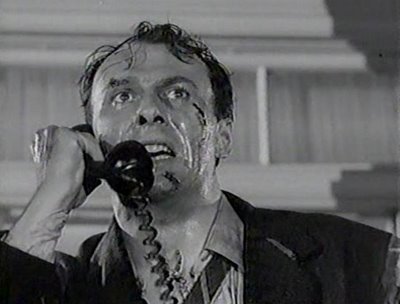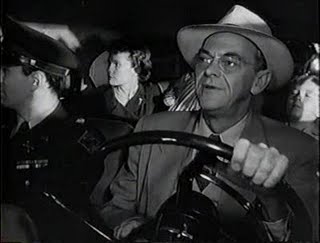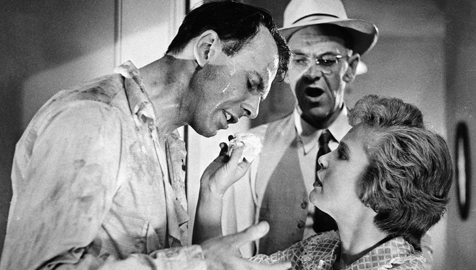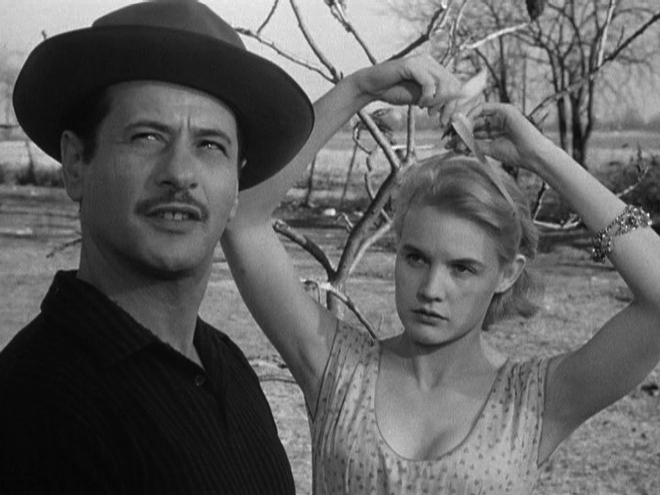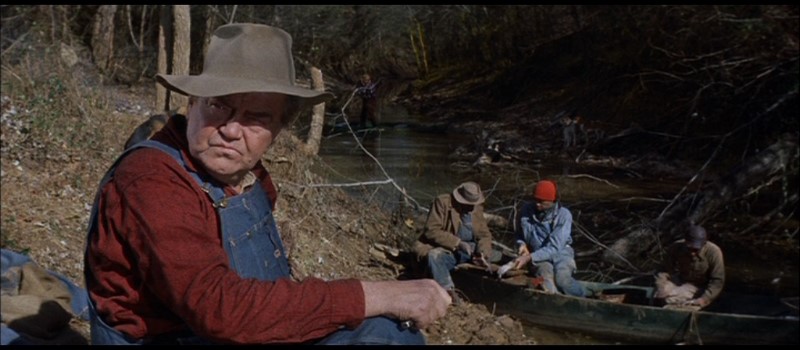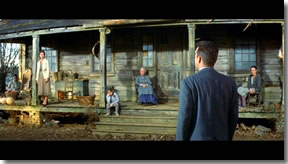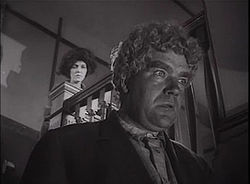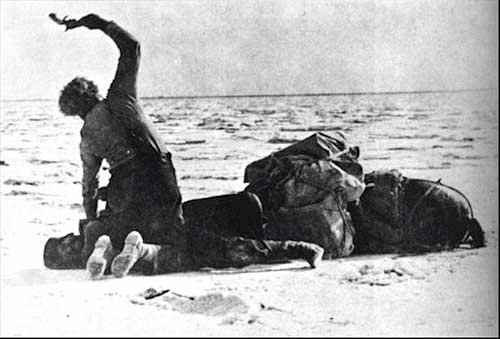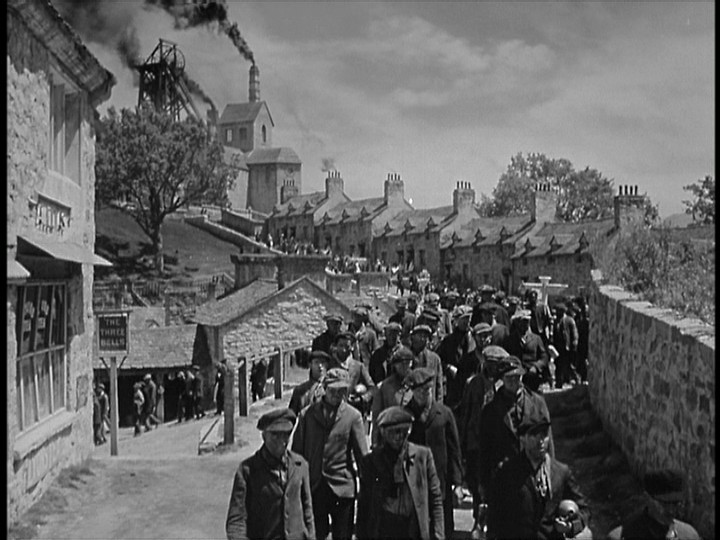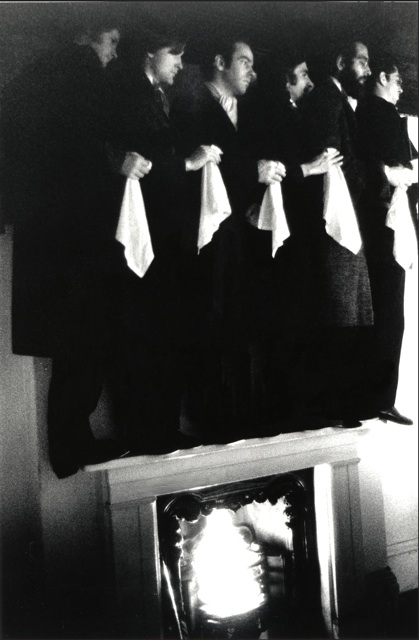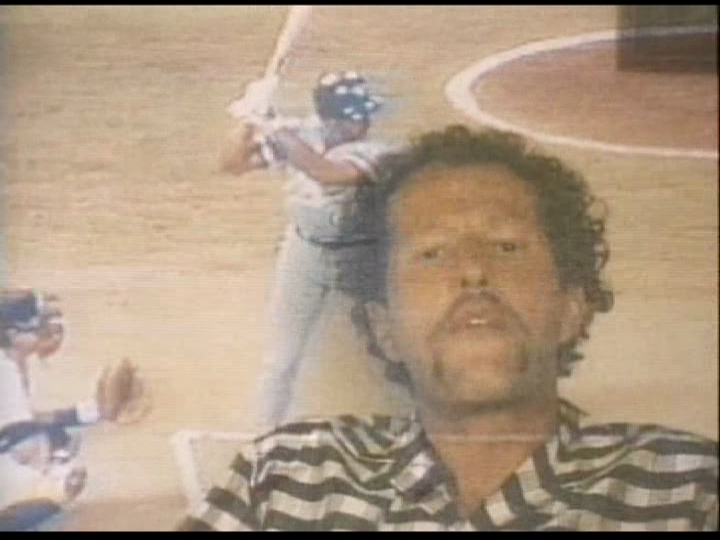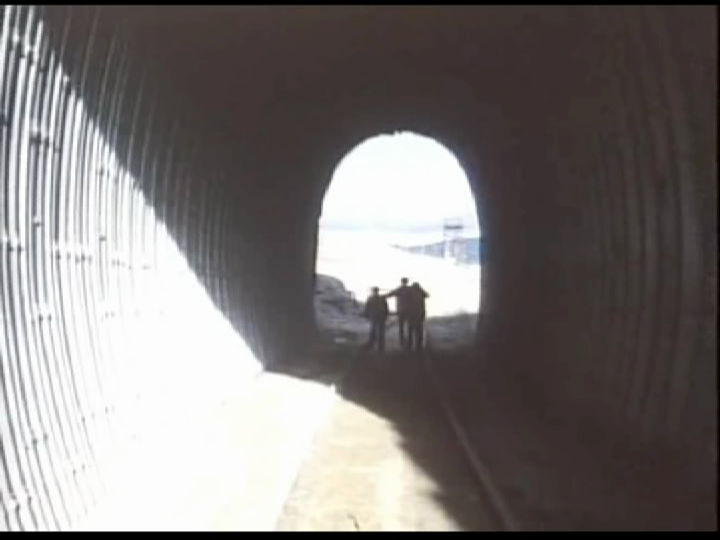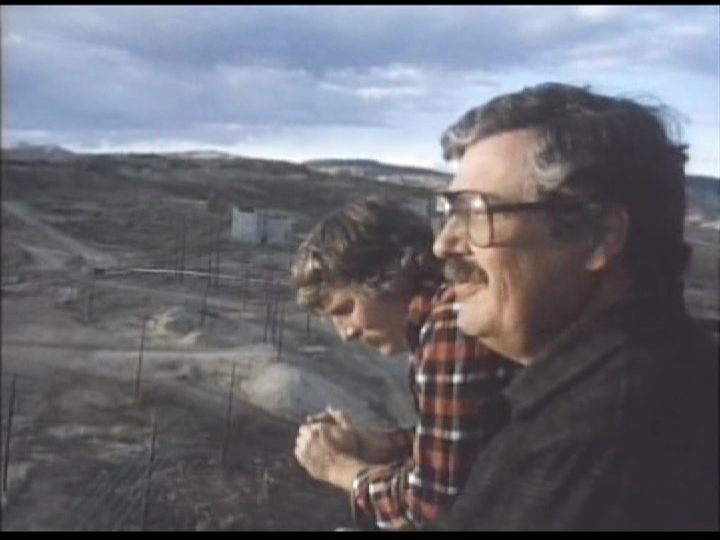This was commissioned by and written for the Rotterdam International Film Festival — specifically for a booklet of essays entitled Grandeur Locale that they published in late January 1992. — J.R.
1. “We acknowledge with gratitude and admiration the spirit of cooperation of the 25,000 citizens of Phenix City, Alabama,” reads a title after the credits of Phil Karlson’s remarkable film noir, THE PHENIX CITY STORY (1955), shot on location less than a year after the events it describes took place. “…To the Mayors and the City Commissioners, the Chiefs of Police, and the many thousand citizens of Columbus, Georgia, and Phenix City, Alabama, who contributed immeasurably to the making of this picture…our sincerest thanks.” For once, the standard courtesy of such an acknowledgement becomes the literal truth. In many prints of the film, we meet four of the local, real-life participants in the story we’re about to see even before the credits come on. The singular accents and speech patterns of these people are literally the sound of my own childhood: I was thirteen years old and had lived all my life in Alabama when the film was released, and to see the film in 1955 was to experience some of the truth of my home state on the screen for the very first time. Thirty-seven years later, that same truth remains, in contrast to the falsity of a tissue of Hollywood lies and distortions like MISSISSIPPI BURNING (1988) – a movie handicapped by its clumsy attempt to represent Mississippi in 1964, with scant attention to local customs, accents, speech patterns, and other forms of regional behavior, not to mention the facts of the civil rights movement and the specific conditions that provoked it. Although MISSISSIPPI BURNING was shot in Mississippi and Alabama, its ignorance about both the region and its history is evident in almost every frame. (Two examples out of many: When Willem Dafoe and Gene Hackman enter a luncheonette and Dafoe insists on joining the black men seated at a segregated counter, the filmmakers ignore the fact that, because of local segregation laws, no such seating arrangement was possible in Mississippi in 1964, where blacks were not allowed as customers anywhere inside of white restaurants. And the fact that these characters, both FBI agents, are the heroes of the film is an insult to the civil rights movement, which triumphed more in spite of the FBI than because of it.)
I don’t mean to suggest by the above that THE PHENIX CITY STORY is a documentary, even if it starts like one and is informed throughout -– even when it veers into hysterical melodrama like MISSISSIPPI BURNING — by documentary truths. The film’s form is clearly docudrama, and it is interesting to note how the signifiers of documentary are used after the credits as part of the transition into the drama. We begin with an ‘impersonal’ voice-off describing Phenix City and Columbus that shortly becomes ‘personal’ when we realize that the voice belongs to the film’s hero, John Patterson (Richard Kiley). Something similar occurs at the very end of the film, when we see this character, now the Attorney General of Alabama, seated behind his office desk addressing the camera, as if he were the ‘real’ John Patterson speaking to us and not an actor. Yet in the film’s genuinely documentary prologue, we have already met Patterson’s real-life mother -– a figure we are implicitly invited to weigh against the actress who later portrays her — and director Phil Karlson similarly mixes professionals with non-professionals and locals with non-locals throughout the film, in a manner that encourages everyone – actors, extras, and even spectators – to become critical analysts of authenticity. The film’s writing credits — assigned to both Crane Wilbur working in Phenix City and Daniel Mainwaring (the screenwriter of OUT OF THE PAST, THE TALL TARGET, and INVASION OF THE BODY SNATCHERS) working in Hollywood – suggests a dialectic analogous to the one between trained actors and local extras. And in a related obsession with verisimilitude that recalls Erich von Stroheim, Karlson even dressed John McIntire – who plays Albert Patterson, the film’s principal murder victim – in the same clothes worn by the dead man when he was killed.
A comparable sense of fidelity to southern folkways (if not to recent history) can be found only a year later in Tennessee Williams’ and Elia Kazan’s black comedy BABY DOLL (1956) , filmed on location in Mississippi. Kazan took the trouble to hire a voice coach who trained the actors to speak with the correct accents, and his use of locals in bit parts is no less inspired. (It’s worth recalling that Kazan had already familiarized himself somewhat with the Deep South in 1937, when he made his very first film, the documentary short THE PEOPLE OF THE CUMBERLANDS, in Tennessee.)
2. Kazan can indeed be considered a pioneer in regional location shoots for Hollywood features – a trend that started with his third feature, BOOMERANG (1947), and continued with PANIC IN THE STREETS (1950) and ON THE WATERFRONT (1954) before he got around to BABY DOLL. Later on came such on-location features as A FACE IN THE CROWD (1957), WILD RIVER (1960), AMERICA, AMERICA (1963), and THE VISITORS (1972).
Undoubtedly part of the credit for this trend is due to the producer Louis de Rochemont, one of the original creators of the documentary shorts THE MARCH OF TIME in 1934, who, after he joined 20th Century-Fox in 1943, encouraged location shooting in such Henry Hathaway thrillers as THE HOUSE ON 92ND STREET (1945) as well as BOOMERANG. Other Hollywood pioneers in this tendency – which included Jules Dassin (BRUTE FORCE, THE NAKED CITY, and THIEVES’ HIGHWAY), Otto Preminger (THE THIRTEENTH LETTER, ANATOMY OF A MURDER), and Cy Endfield (TRY AND GET ME!), among many others – seemed to find it easier to shoot thrillers on location than other kinds of films with contemporary settings. (The aforementioned Phil Karlson, who also belongs to this trend, returned to it with less happy results in his profitable 1973 docudrama feature WALKING TALL – a near remake of THE PHENIX CITY STORY, also shot on location in the South, where the crypto-fascist endorsement of violent revenge already implicit in THE PHENIX CITY STORY is allowed to dominate.)
3. Local shooting in which real places and/or their inhabitants play an integral role has of course many separate histories in the United States, ranging from the earliest turn-of-the-century travelogues to the recent regional productions of George Romero (Pittsburgh) and John Waters (Baltimore). But we can conveniently start with Stroheim’s GREED (1923-24), a touchstone of the silent era that was shot exclusively in the California locations where the story unfolds – chiefly the gold mining country in Placer county, San Francisco, and Oakland (most of the shooting), and Death Valley. While it clearly wasn’t the first Hollywood on-location feature, it is certainly one of the few that made such an impact on the industry that it remains a key reference point even today.
To the best of my knowledge, Stroheim was not especially interested in casting locals in GREED except as extras. Although there are undoubtedly exceptions to this rule in silent films shot on location, it appears that the desire to use locals as actors increases substantially after sound comes in and regional accents become an issue. It’s worth adding, however, that Stroheim’s fanatical efforts to reproduce the `real’ led him into certain contradictions regarding his use of locations. In an unpublished interview with Kevin Brownlow, William Daniels has remarked that Stroheim’s passion for crowding naturalistic details into shots, and his refusal to compromise on camera placements once particular setups had been decided upon, occasionally led him to have walls torn down in his `natural’ locations in order to make room for the camera. Inevitably, this procedure – and the absence of reverse angles that it necessitated — led, willy-nilly, to the artificially missing `fourth wall’ of the stage, and there are moments throughout GREED when theatrical, proscenium-arch framing becomes one of Stroheim’s resources for articulating his ‘documentary’ realism.
4. An interesting example of how a sense of locality and even `local color’ can be artificially created rather than found is John Ford’s HOW GREEN WAS MY VALLEY (1941). The illusion that the film was shot in Wales rather than in Hollywood is as striking as the fixed age of its narrator hero Huw Morgan. As he is about to leave his Welsh mining valley at the age of fifty, Huw Morgan recounts his childood there for the remainder of the film, and while many years pass during these childhood memories, this character – as played by Roddy McDowall, in contrast to the other characters – is never seen to age at all. Indeed, as Ford’s biographer and critic Tag Gallagher has pointed out, this `conventional stage fiction’ is used by Ford as a symbol of the stasis of both this character and the culture he inhabits, locked into inflexible habits and traditions that eventually turn his green valley into a slagheap.
Considering the importance of a fixed locality in this movie, it is interesting to speculate what it would have been like if Ford and producer Darryl F. Zanuck had actually managed to shoot this adaptation of Richard Llewellyn’s best selling novel on location rather than in the Malibu hills and on 20th Century-Fox sound stages. To quote the film’s screenwriter, the recently deceased Philip Dunne:
In 1940, momentous events in Europe were directly affecting our movie. Zanuck, one of whose most endearing characteristics was his ability to inspire enthusiasm in his apostles, had projected for me a colossal HOW GREEN WAS MY VALLEY, which would have been our answering to the reigning colossus, GONE WITH THE WIND. I was to write a four-hour picture, which would be shot in glorious Technicolor on location in Wales with an all-star cast.
In August, one bubble burst with the beginning of the Battle of Britain. South Wales, Britain’s principal source of coal, was a primary target for Hitler’s Luftwaffe, and all plans to be shot on location there had to be scrapped. A location the hills behind Malibu was suggested by the art department. I flew over it in a light plane to inspect it. I immediately realized that the dull olive chaparral of arid Southern California could never substitute for the vivid green of rain-swept Cwm Rhondda, and wrote Zanuck a memo regretfully suggesting that the idea of shooting in color should also be scrapped. Back came in red ink word that the decision to scrap it had already been made. All this had some effect on my screenplay: scenes that I had planned for the Welsh location were rewritten to play in our village street set or on sound stages. (“No Fence Around Time,” introductory essay to Dunne’s HOW GREEN WAS MY VALLEY screenplay, Santa Barbara, CA: Santa Teresa Press, 1990)
5. All my examples so far have been Hollywood releases, including those pictures (such as ANATOMY OF A MURDER) that were produced independently. When it comes to independent filmmakers, on the other hand, location shooting and the casting of locals is the rule rather than the exception -– a rule that applies to everything from John Cassavetes’ SHADOWS to Michael Snow’s WAVELENGTH (a Canadian film, but one shot in New York), to Mark Rappaport’s appropriately titled LOCAL COLOR to the features of Jon Jost. (Exceptions to this rule tend to be independent productions with relatively high budgets such as Sally Potter’s THE GOLD DIGGERS, filmed in Iceland, and Jim Jarmusch’s MYSTERY TRAIN, shot in Memphis, Tennessee, both shot with non-locals.)
Jost’s BELL DIAMOND (1987), shot for $25,000 in Butte, Montana, could be described as the first feature shot by Jost in his `second manner’ – a method subsequently followed in his REMBRANDT LAUGHING (1989), ALL THE VERMEERS IN NEW YORK (1990), and SURE FIRE (1990), as well as his more recent work. This consists of settling down in a particular locale for several weeks or months – Butte in BELL DIAMOND, San Francisco in REMBRANDT, Manhattan in ALL THE VERMEERS, rural Utah in SURE FIRE – and gradually putting together a story with the help of his actors, many of them locals who improvise their dialogue. An earlier version of this technique was employed in SLOW MOVES (1983), although significant portions of the film took place on the road after beginning in the San Francisco area.
Both SLOW MOVES and BELL DIAMOND employ the same lead actor, Marshall Gaddis. In the latter film, Gaddis plays a Vietnam War veteran and TV addict whose wife leaves him. Although, like SLOW MOVES and SURE FIRE, BELL DIAMOND has a single central character (Gaddis), it also anticipates REMBRANDT and ALL THE VERMEERS in showing us a circle of friends and acquaintances, describing the edges of what might be called a community, and it is the only film in this series that situates this community within a small town. With a wandering, leisurely plot that suggests European cinema more often than Hollywood – and which manages to make room for some archival footage shot in Butte around 1920, a 360-degree pan across a crowd of locals looking directly into the camera – BELL DIAMOND proposes a kind of home-grown cinema that takes root in specific, home-grown circumstances, miles away from the standardized urban and suburban settings that comprise most Hollywood cinema.


